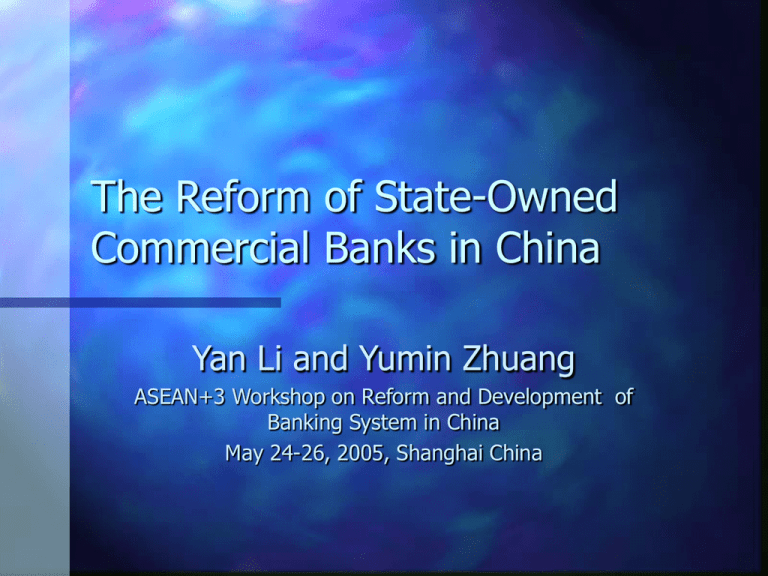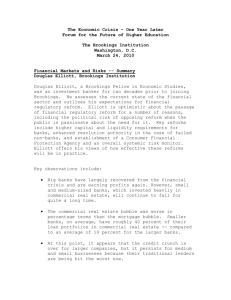The Reform of State-Owned Commercial Banks in China
advertisement

The Reform of State-Owned Commercial Banks in China Yan Li and Yumin Zhuang ASEAN+3 Workshop on Reform and Development of Banking System in China May 24-26, 2005, Shanghai China Contents Overview of China’s state-owned commercial banks The history of state-owned commercial banks The process of reform Conclusion Overview of China’s state-owned commercial banks (SOCBs) The history of state-owned commercial banks The progress of reform Conclusion Overview of China’s SOCBs Framework of China’s banking system People’s Bank of China Big four Industrial and commercial bank of China (ICBC) Agricultural Bank of China (ABC) Bank of China (BOC) Construction Bank of China (CBC) Joint-stock banks (12 banks) Urban credit cooperatives (709 banks) Policy banks (3 banks) Rural credit cooperatives (33,586 banks) City commercial banks (112 banks) Foreign banks (119 operation branches 216 representative offices) The dominance of banks over capital market CORPORATE BONDS OUTSTANDING 1% BANK ASSETS 76% GOVERNMENT BONDS OUTSTANDING 8% STOCK MARKET CAPITALIZATIO N 15% SIZE AND COMPOSITION OF CHINA'S FINANCIAL SYSTEM-2002 The dominance of big four over other banks Rural Credit Cooperatives 10% Urban Credit Cooperatives Rural 1% Commercial Banks 2% City Commercial Banks Joint-stock 5% Commercial Banks 15% Postal Savings Institution 3% Foreign Banks 2% Policy Banks 8% SOCBs 54% COMPOSITION OF BANK ASSETS IN CHINA-2004 The dominance of big four over all other financial institutes The Assets, Deposits and Loans of Financial Institutions RMB100 Million yuan, % Balance Total Policy Banks SOCBs Joint-stock Commercial Banks City Commercial Banks Rural Commercial Banks Urban Credit Cooperatives Rural Credit Cooperatives Trust Corporations Finance Companies Leasing Companies Postal Savings Institution Foreign Banks Assets shares 316006.68 24122.48 169320.5 46972.2 17056.3 565.36 1786.76 30767.02 2674.09 5854.1 215.37 10849.6 5822.9 Deposits Balance shares 1 248988.62 7.63% 1274.87 53.58% 144417.48 14.86% 40598.84 5.40% 14145.58 2.34% 500.8 0.57% 1588.76 9.74% 27340.16 0.85% 1750.11 1.85% 4954.1 0.07% 69.32 3.43% 10849.6 1.84% 1499 Source: the People’s Bank of China database, 2004. Balance Loans shares 1 189298.46 0.51% 22228.24 58.00% 101182.99 16.31% 28859.41 5.68% 9030.97 309.7 0.64% 1014.54 10.98% 19241.56 0.70% 1331.85 1.99% 3097.8 0.03% 157.2 4.36% 0 0.60% 2844.2 1 11.74% 53.45% 15.25% 4.77% 0.54% 10.16% 0.70% 1.64% 0.08% 0.00% 1.50% Overview of China’s SOCBs (continue) Conclusion: Financial institutes are dominated by banks Banks are dominated by SOCBs China’s fragile financial system means China’s fragile SOCBs Financial reform = SOCBs reform Overview of China’s state-owned commercial banks The history of state-owned commercial banks The progress of reform Conclusion The history of SOCBs SOCBs were born in 1979—the first stage of financial reform One bank and dual role Central bank and commercial bank Only source of loans and the center of disturbing investment and operating funds to SOEs Confliction of dual function SOCBs are from Peoples Bank of China ABC—a rebirth from PBC BOC—a separation of PBC’s foreign exchange division CCB—transferred from PBC (1983) ICBC—transferred from PBC (1984) The history of SOCBs (continue) SOCBs is the products of financial reform in China Problems left in SOCBs Loan to inefficient SOEs Government agency but “genuine bank” Non-profit orientation Bureaucratism and Corruption Monopoly on specified areas – Competition was not allowed among big four No risk consciousness Accumulation of Bad loans Performance Comparison of BOCBs with the Top 10 in 2004 (Million Dollars) Total Assets Net asset /total asset Top 10 average SOCBs average 991704 472770 4.51 4.26 Earnings before tax 11224 486 ROA 1.16 0.11 NPL 3.19 19.2 Earnings per employee 152.19 2.49 Overview of China’s state-owned commercial banks The history of state-owned commercial banks The progress of reform Conclusion The progress of reform Phase I (1979-1993): the forming of framework of modern banking system Phase II (1994-1999): transition from specialized bank to commercial bank Phase III (since 2000): SOCBs Comprehensive Reform The progress of reform (cont 1) Phase II (1994-1999): transition from specialized bank to commercial bank 1994, recast Big Four as commercial banks Creating 3 policy banks to divorce Big Four from “policy loan” dictated by government – China Agriculture Development Bank – China Development Bank – China Import and Export Bank 1995, pass the Commercial Bank Law Enabling Big Four to become genuine commercial banks Segregating business operations of banks, securities firms and insurance companies The progress of reform (cont 2) Asia financial crisis in 1997 speed up the reform of SOCBs in 1998 Highly concentrated supervision power in PBOC was separated into 3 parts: – PBOC – China Securities Regulatory Commission – China Insurance Regulatory Commission Injecting $33 billion of capital into the Big Four to strengthen their ability of anti-risk The progress of reform (cont 3) 1999, Establishing four asset-management companies, one for each of the banks AMCs absorbed $169 billion in non-performing loans By the end of 2003 they had disposed of $61.5 billion in bad loans, recovering some $12 billion The progress of reform (cont 4) Phase III (since 2000): SOCBs Comprehensive Reform A compressed timeframe of reform China’s WTO entrance requires all banks (domestic and foreign) compete under the same conditions by the end of 2006 Problems faced by SOCBs The progress of reform (cont 5) High non-performing loan ratio NPL ratio SOCBs Japanese banks in average French banks in average British banks in average American banks in average 2001 25.40% Source: database from People’s Bank of China – A fragile banking system 2003 20.36% 4.50% 4.20% 2.40% 1.80% The progress of reform (cont 6) Low profitability Profit on Asset (%) SOCBs ICBC ABC BOC CBC Joint-stock banks Foreign banks in China 1999 0.11% 2000 0.13% 0.36% 2.67% 0.39% 1.92% 2001 0.12% 0.14% -0.24% 0.35% 0.21% 0.30% 2.26% Source: China Financial Yearbook, 1999-2003 2002 0.24% 0.13% -0.03% 0.45% 0.50% - - Profit Per Employee (thousand dollars) SOCBs(excludes ABC) Top 10 banks in the world 2003 2.5 152 The progress of reform (cont 7) Capital inadequacy The Capital Adequacy Ratio of SOCBs 1997 1999 ICBC 2.55% 5.70% ABC 2.14% 5.10% BOC 4.70% 3.00% CBC 2.73% 2.50% 2002 5.54% 1.44% 8.15% 6.91% Source: Annual report of Big Four – Capital adequacy ratio had been reached 8% after Ministry of Finance injecting $33 billion in SOCBs in 1998. But the ratio kept declining after that The progress of reform (cont 8) – Reason of capital inadequacy: Few ways of increasing capital Low profitability Rapid extension of credit Poor corporate governance mechanism – The principles of corporate governance mechanism (codified by OECD) include: Independent board of directors Treatment of minority shareholders Coordinating the interests of capital owners and business managers. The progress of reform (cont 9) – Banks operate on a commercial basis with modern corporate governance should have: Independent boards of directors Sound internal control and risk management Comprehensive external audits Foreign strategic investors – SOCBs have poor corporate governance mechanism Close relation with government. Bankers are government officers but not business men. Weak incentives to support business operating Weak internal control and risk management The progress of reform (cont 10) Resolutions Improve the supervision and regulation environment – Creating China Banking Regulation Commission – Narrowing the focus of PBC on monetary policy Increase capital adequacy and writing-off NPLs – Injecting capital into SOCBs $45 billion into BOC and CBC in 2003; $15 billion into ICBC in May 2005 – Issuing subordinated bonds RMB 49.4 billion by BOC and CBC in 2004 The progress of reform (cont 11) Improve legal environment – Passing three banking laws Transfer from wholly state-owned bank to jointstockholding bank – BOC and CBC as the pilot of test suppose to go to public in 2005 – ICBC suppose to go to public in 2006 Improve corporate governance mechanism – BOC and CBC have established the General Meeting of Shareholders, the Board of Directors, the Board of supervisors – Under the board of directors, five committees are set up, including Strategy Committee, Risk Management Committee, Audit Committee, Nomination & Remuneration Committee, Related Transaction Committee The progress of reform (cont 12) – All efforts made to achieve the goals: Strengthen risk management & internal control Reform of the Human Resources Management Create prudential Accounting System Increase transparency Establish Huijin company – A government agency – Function A representative of state stock holder Supervise the business operating of SOCBs The progress of reform (cont 13) Problems in joint-stock holding reform of SOCBs Who select the top manager of bank? – A dilemma of state control and shareholder’ s interest – Government doesn't want to give up control How to attract strategic investors? – The average equity size SOCBs is about RMB 150 billion, take 20% of equity need RMB 30 billion. It is a huge number for most potential investors Overview of China’s state-owned commercial banks The history of state-owned commercial banks The progress of reform Conclusion Conclusion Reform is slowly but steady during the past quarter of century Spin of commercial operating from people’s bank of China into separated commercial banks Strengthen the rule of law in financial system Fight against NPLs Improving the governance of banks It is a long way but a bright way THANKS!




